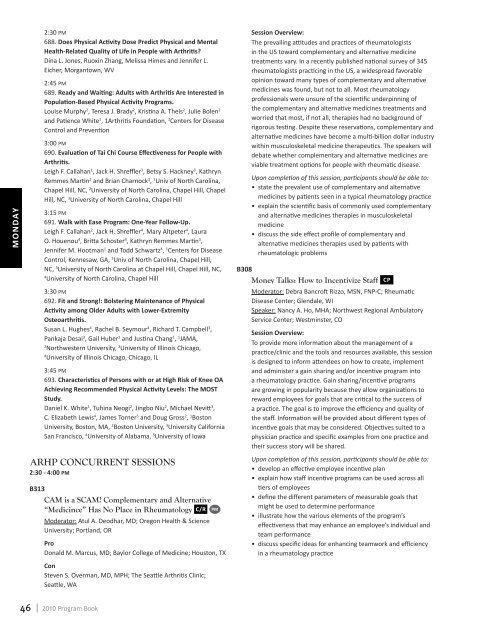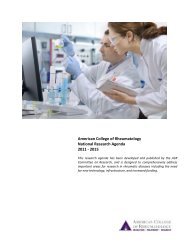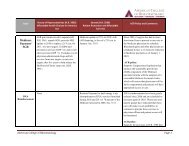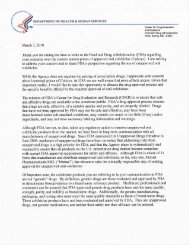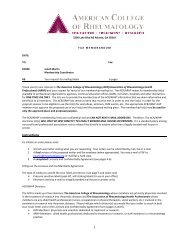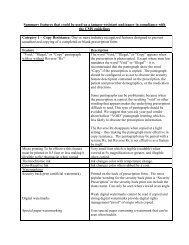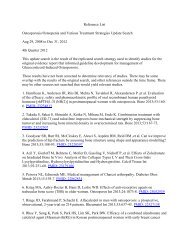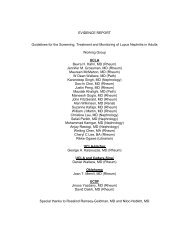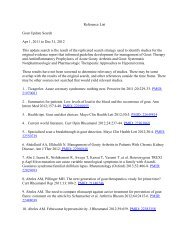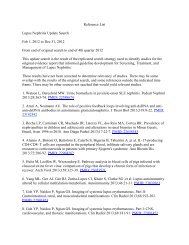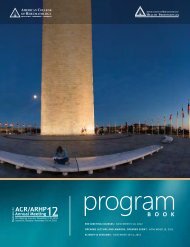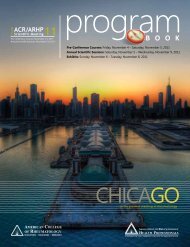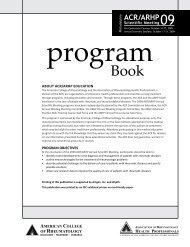B O O K - American College of Rheumatology
B O O K - American College of Rheumatology
B O O K - American College of Rheumatology
You also want an ePaper? Increase the reach of your titles
YUMPU automatically turns print PDFs into web optimized ePapers that Google loves.
monday<br />
2:30 PM<br />
688. Does Physical Activity Dose Predict Physical and Mental<br />
Health-Related Quality <strong>of</strong> Life in People with Arthritis?<br />
Dina L. Jones, Ruoxin Zhang, Melissa Himes and Jennifer L.<br />
Eicher, Morgantown, WV<br />
2:45 PM<br />
689. Ready and Waiting: Adults with Arthritis Are Interested in<br />
Population-Based Physical Activity Programs.<br />
Louise Murphy 2 , Teresa J. Brady 2 , Kristina A. Theis 2 , Julie Bolen 2<br />
and Patience White 1 , 1Arthritis Foundation, 2 Centers for Disease<br />
Control and Prevention<br />
3:00 PM<br />
690. Evaluation <strong>of</strong> Tai Chi Course Effectiveness for People with<br />
Arthritis.<br />
Leigh F. Callahan 1 , Jack H. Shreffler 3 , Betsy S. Hackney 3 , Kathryn<br />
Remmes Martin 2 and Brian Charnock 3 , 1 Univ <strong>of</strong> North Carolina,<br />
Chapel Hill, NC, 2 University <strong>of</strong> North Carolina, Chapel Hill, Chapel<br />
Hill, NC, 3 University <strong>of</strong> North Carolina, Chapel Hill<br />
3:15 PM<br />
691. Walk with Ease Program: One-Year Follow-Up.<br />
Leigh F. Callahan 2 , Jack H. Shreffler 4 , Mary Altpeter 4 , Laura<br />
O. Houenou 4 , Britta Schoster 4 , Kathryn Remmes Martin 3 ,<br />
Jennifer M. Hootman 1 and Todd Schwartz 4 , 1 Centers for Disease<br />
Control, Kennesaw, GA, 2 Univ <strong>of</strong> North Carolina, Chapel Hill,<br />
NC, 3 University <strong>of</strong> North Carolina at Chapel Hill, Chapel Hill, NC,<br />
4<br />
University <strong>of</strong> North Carolina, Chapel Hill<br />
3:30 PM<br />
692. Fit and Strong!: Bolstering Maintenance <strong>of</strong> Physical<br />
Activity among Older Adults with Lower-Extremity<br />
Osteoarthritis.<br />
Susan L. Hughes 4 , Rachel B. Seymour 4 , Richard T. Campbell 3 ,<br />
Pankaja Desai 3 , Gail Huber 2 and Justina Chang 1 , 1 JAMA,<br />
2<br />
Northwestern University, 3 University <strong>of</strong> Illinois Chicago,<br />
4<br />
University <strong>of</strong> Illinois Chicago, Chicago, IL<br />
3:45 PM<br />
693. Characteristics <strong>of</strong> Persons with or at High Risk <strong>of</strong> Knee OA<br />
Achieving Recommended Physical Activity Levels: The MOST<br />
Study.<br />
Daniel K. White 1 , Tuhina Neogi 2 , Jingbo Niu 2 , Michael Nevitt 3 ,<br />
C. Elizabeth Lewis 4 , James Torner 5 and Doug Gross 2 , 1 Boston<br />
University, Boston, MA, 2 Boston University, 3 University California<br />
San Francisco, 4 University <strong>of</strong> Alabama, 5 University <strong>of</strong> Iowa<br />
ARHP Concurrent Sessions<br />
2:30 - 4:00 PM<br />
B313<br />
CAM is a SCAM! Complementary and Alternative<br />
“Medicince” Has No Place in <strong>Rheumatology</strong> c/r PM<br />
Moderator: Atul A. Deodhar, MD; Oregon Health & Science<br />
University; Portland, OR<br />
Pro<br />
Donald M. Marcus, MD; Baylor <strong>College</strong> <strong>of</strong> Medicine; Houston, TX<br />
Con<br />
Steven S. Overman, MD, MPH; The Seattle Arthritis Clinic;<br />
Seattle, WA<br />
Session Overview:<br />
The prevailing attitudes and practices <strong>of</strong> rheumatologists<br />
in the US toward complementary and alternative medicine<br />
treatments vary. In a recently published national survey <strong>of</strong> 345<br />
rheumatologists practicing in the US, a widespread favorable<br />
opinion toward many types <strong>of</strong> complementary and alternative<br />
medicines was found, but not to all. Most rheumatology<br />
pr<strong>of</strong>essionals were unsure <strong>of</strong> the scientific underpinning <strong>of</strong><br />
the complementary and alternative medicines treatments and<br />
worried that most, if not all, therapies had no background <strong>of</strong><br />
rigorous testing. Despite these reservations, complementary and<br />
alternative medicines have become a multi-billion dollar industry<br />
within musculoskeletal medicine therapeutics. The speakers will<br />
debate whether complementary and alternative medicines are<br />
viable treatment options for people with rheumatic disease.<br />
Upon completion <strong>of</strong> this session, participants should be able to:<br />
• state the prevalent use <strong>of</strong> complementary and alternative<br />
medicines by patients seen in a typical rheumatology practice<br />
• explain the scientific basis <strong>of</strong> commonly used complementary<br />
and alternative medicines therapies in musculoskeletal<br />
medicine<br />
• discuss the side effect pr<strong>of</strong>ile <strong>of</strong> complementary and<br />
alternative medicines therapies used by patients with<br />
rheumatologic problems<br />
B308<br />
Money Talks: How to Incentivize Staff cP<br />
Moderator: Debra Bancr<strong>of</strong>t Rizzo, MSN, FNP-C; Rheumatic<br />
Disease Center; Glendale, WI<br />
Speaker: Nancy A. Ho, MHA; Northwest Regional Ambulatory<br />
Service Center; Westminster, CO<br />
Session Overview:<br />
To provide more information about the management <strong>of</strong> a<br />
practice/clinic and the tools and resources available, this session<br />
is designed to inform attendees on how to create, implement<br />
and administer a gain sharing and/or incentive program into<br />
a rheumatology practice. Gain sharing/incentive programs<br />
are growing in popularity because they allow organizations to<br />
reward employees for goals that are critical to the success <strong>of</strong><br />
a practice. The goal is to improve the efficiency and quality <strong>of</strong><br />
the staff. Information will be provided about different types <strong>of</strong><br />
incentive goals that may be considered. Objectives suited to a<br />
physician practice and specific examples from one practice and<br />
their success story will be shared.<br />
Upon completion <strong>of</strong> this session, participants should be able to:<br />
• develop an effective employee incentive plan<br />
• explain how staff incentive programs can be used across all<br />
tiers <strong>of</strong> employees<br />
• define the different parameters <strong>of</strong> measurable goals that<br />
might be used to determine performance<br />
• illustrate how the various elements <strong>of</strong> the program’s<br />
effectiveness that may enhance an employee’s individual and<br />
team performance<br />
• discuss specific ideas for enhancing teamwork and efficiency<br />
in a rheumatology practice<br />
46<br />
2010 Program Book


